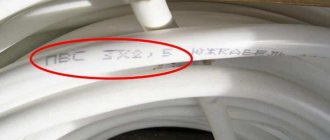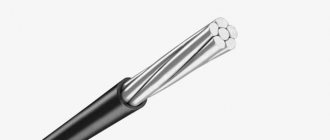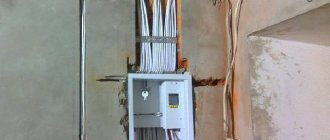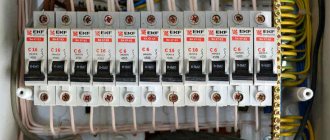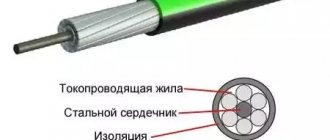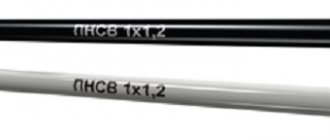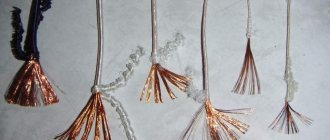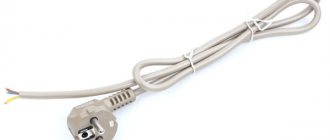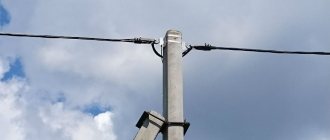Today, the cable market offers many brands of wires designed for various purposes. Perhaps the most versatile and most in demand is the SHVVP wire (cord). The cable's popularity has grown due to its extraordinary flexibility and other mechanical characteristics.
The main purpose of SHVVP cords is to connect various household appliances. It is rated for 220 or 380 V, although it can withstand short-term peak voltages of up to 2 kV. The permissible load is determined by the cross-section of the cores. For example, with a conductor cross-section of 0.75 mm2, the wire can be used to connect low-power devices consuming a rated current of no more than 6 A.
Decoding
If we consider in detail the meaning of the abbreviation SHVVP, it will become clear that this is not a wire or a cable, but a cord. A cord is an electrical product designed to connect consumers to an alternating current network and having several (at least two) cores. The current-carrying conductors are mainly elastic and have a cross-section of up to 0.75 mm2.
Attention! If the housing of the connected household appliance does not require a grounding conductor, then the cord has two conductive wires. According to GOST 7399 - 97, this is a household cord. In other cases, the cords are multi-core products.
Three-core ball screw
The marking is an inscription that combines letters and numbers. It is applied to the surface of the conductor every meter. The decryption has the following meaning:
- Ш – cord;
- B – polyvinyl chloride (PVC) sheath of current-carrying conductors;
- B – polyvinyl chloride (PVC) outer shell;
- P – flat.
Double insulation makes the cord safer with respect to electrical effects on humans. In addition, PVC materials are not subject to active combustion.
table 2
| Brand of cord or wire | Number and nominal cross-section of cores, mm2 | Core class or design | External dimensions, mm | Electrical insulation resistance at 70°C, MO | |
| min. | Max. | ||||
| SHOG (SHOG-S) | — | Two strands of tinsel threads | 2,2×4,4 | 3,5×7,0 | 0,019 |
| 2,4×5,0* | 3,0×6,0* | ||||
| Ball screw | 2×0,50 | 6 | 2,4×4,9 | 3,0×5,9 | 0,016 |
| 2,5×5,0* | 2,8×5,6* | ||||
| 2×0,75 | 2,6×5,2 | 3,1×6,3 | 0,014 | ||
| 2,7×5,4* | 3,0×6,0* | ||||
| SHVD | 1×0,50 | 6 | 2,3 | 2,7 | 0,014 |
| 1×0,75 | 2,4 | 2,9 | 0,012 | ||
| SHVVP | 2×0,50 | 5 | 3,0×4,9 | 3,7×5,9 | 0,012 |
| 3,0×4,9* | 3,4×5,4* | ||||
| 2×0,75 | 3,2×5,2 | 3,8×6,3 | 0,010 | ||
| 3,2×5,2* | 3,6×5,8* | ||||
| 3×0,50 | 3,0×6,8 | 3,7×8,2 | 0,012 | ||
| 3,0×6,8* | 3,3×7,4* | ||||
| 3×0,75 | 3,2×7,2 | 3,8×8,7 | 0,010 | ||
| 3,2×7,4* | 3,6×8,2* | ||||
| ShVL | 2×0,50 | 5 | 4,6 | 5,9 | 0,012 |
| 4,8* | 5,4* | ||||
| 2×0,75 | 4,9 | 6,3 | 0,010 | ||
| 5,2* | 5,8* | ||||
| 3×0,50 | 4,9 | 6,3 | 0,012 | ||
| 5,0* | 5,7* | ||||
| 3×0,75 | 5,2 | 6,7 | 0,010 | ||
| 5,4* | 6,1* | ||||
| PVS | 2×0,75 | 5 | 5,7 | 7,2 | 0,011 |
| 6,0* | 6,6* | ||||
| 2×1,00 | 5,9 | 7,5 | 0,010 | ||
| 6,4* | 7,0* | ||||
| 2×1,50 | 6,8 | 8,6 | 0,010 | ||
| 7,4* | 8,2* | ||||
| 2×2,50 | 8,4 | 10,6 | 0,009 | ||
| 3×0,75 | 6,0 | 7,6 | 0,011 | ||
| 6,4* | 7,0* | ||||
| 3×1,00 | 6,3 | 8,0 | 0,010 | ||
| 6,8* | 7,6* | ||||
| 3×1,50 | 7,4 | 9,4 | 0,010 | ||
| 8,0* | 8,8* | ||||
| 3×2,50 | 9,2 | 11,4 | 0,009 | ||
| 4×0,75 | 6,6 | 8,3 | 0,011 | ||
| 4×1,00 | 7,1 | 9,0 | 0,010 | ||
| 4×1,50 | 8,4 | 10,5 | 0,010 | ||
| 4×2,50 | 10,1 | 12,5 | 0,009 | ||
| 5×0,75 | 7,4 | 9,3 | 0,011 | ||
| 5×1,00 | 7.8 | 9,8 | 0,010 | ||
| 5×1,50 | 9,3 | 11,6 | 0,010 | ||
| 5×2,50 | 11,2 | 13,9 | 0,009 | ||
| PVSP | 2×0,75 | 3,7×6,0 | 4,5×7,2 | 0,011 | |
| 3,8×6,0* | 4,3×6,8* | ||||
| ShRO | 2×0,75 | 5,5 | 7,2 | ||
| 5,8* | 7,2* | ||||
| 2×1,00 | 5,7 | 7,6 | |||
| 6,2* | 7,5* | ||||
| 2×1,50 | 6,2 | 8,2 | |||
| 6,8* | 8,1* | ||||
| 3×0,75 | 5,9 | 7,7 | |||
| 6,2* | 7,5* | ||||
| 3×1,00 | 6,2 | 8,1 | |||
| 6,6* | 7,9* | ||||
| 3×1,50 | 6.7 | 8,8 | |||
| 7,2* | 8,6* | ||||
| PRS | 2×0,75 | 5 | 5,7 | 7,4 | — |
| 6,0* | 7,0* | ||||
| 2×1,00 | 6,1 | 8,0 | |||
| 6,6* | 7,6* | ||||
| 2×1,50 | 7,6 | 9,8 | |||
| 8,0* | 9,3* | ||||
| 2×2,50 | 9,0 | 11,6 | |||
| 2×4,00 | 10,5 | 13,7 | |||
| 3×0,75 | 6,2 | 8,1 | |||
| 6,5* | 7,5* | ||||
| 3×1,00 | 6,5 | 8,5 | |||
| 7,0* | 8,1* | ||||
| 3×1,50 | 8,0 | 10,4 | |||
| 8,6* | 10,0* | ||||
| 3×2,50 | 9,6 | 12,4 | |||
| 3×4,00 | 11,3 | 14,5 | |||
| 4×0,75 | 6,8 | 8,8 | |||
| 4×1,00 | 7,1 | 9,3 | |||
| 4×1,50 | 9,0 | 11,6 | |||
| 4×2,50 | 10,7 | 13,8 | |||
| 4×4,00 | 12,5 | 15,9 | |||
| 5×0,75 | 7,6 | 9,9 | |||
| 5×1,00 | 8,0 | 10,3 | |||
| 5×1,50 | 9,8 | 12,7 | |||
| 5×2,50 | 11,9 | 15,3 | |||
| PRM | 2×0,75 | 5,7 | 7,4 | ||
| 6,0* | 7,0* | ||||
| 2×1,00 | 6,1 | 8,0 | |||
| 6,6* | 7,6* | ||||
| 2×1,50 | 7,6 | 9,8 | |||
| 8,0* | 9,3* | ||||
| 2×2,50 | 9,0 | 11,6 | |||
| 6,2 | 8,1 | ||||
| 3×0,75 | 6,2 | 8,1 | |||
| 6,5* | 7,5* | ||||
| PRM | 3×1,00 | 5 | 6,5 | 8,5 | |
| 7,0* | 8,1* | ||||
| 3×1,50 | 8,0 | 10,4 | |||
| 8,6* | 10,0* | ||||
| 3×2,50 | 9,6 | 12,4 | |||
| 4×0,75 | 6,8 | 8,8 | |||
| 4×1,00 | 7,1 | 9,3 | |||
| 4×1,50 | 9,0 | 11,6 | |||
| 4×2,50 | 10.7 | 13,8 | |||
| 5×0,75 | 7,6 | 9,9 | |||
| 5×1,00 | 8,0 | 10,3 | |||
| 5×1,50 | 9,8 | 12,7 | |||
| 5×2,50 | 11,9 | 15,3 | |||
| PSG | 1×1,50 | 5,7 | 7,1 | ||
| 1×2,50 | 6,3 | 7,9 | |||
| 1×4,00 | 7,2 | 9,0 | |||
| 1×6,00 | 7,9 | 9,8 | |||
| 1×10,0 | 9,5 | 11,9 | |||
| 1×16,0 | 10,8 | 13,4 | |||
| 1×25,0 | 12,7 | 15,8 | |||
| 1×35,0 | 14,3 | 17,9 | |||
| 1×50,0 | 16,5 | 20,6 | |||
| 1×70,0 | 18,6 | 23,3 | |||
| 1×95,0 | 20,8 | 26,0 | |||
| 1×120 | 22,8 | 28,6 | |||
| 1×150 | 25,2 | 31,4 | |||
| 1×185 | 27,6 | 34,4 | |||
| 1×240 | 30,6 | 38,3 | |||
| 1×300 | 33,5 | 41,9 | |||
| 1×400 | 37,4 | 46,8 | |||
| 2×1,00 | 7,7 | 10,0 | |||
| 2×1,50 | 8,5 | 11,0 | |||
| 2×2,50 | 10,2 | 13,1 | |||
| 2×4,00 | 11,8 | 15,1 | |||
| 2×6,00 | 13,1 | 16,8 | |||
| 2×10,0 | 17,7 | 22,6 | |||
| PSG | 2×16,0 | 5 | 20,2 | 25,7 | |
| 2×25,0 | 24,3 | 30,7 | |||
| 3×1,00 | 8,3 | 10,7 | |||
| 3×1,50 | 9,2 | 11,9 | |||
| 3×2,50 | 10,9 | 14,0 | |||
| 3×4,00 | 12,7 | 16,2 | |||
| 3×6,00 | 14,1 | 18,0 | |||
| 3×10,0 | 19,1 | 24,2 | |||
| 3×16,0 | 21,8 | 27,6 | |||
| 3×25,0 | 26,1 | 33,0 | |||
| 3×35,0 | 29,3 | 37,1 | |||
| 3×50,0 | 34,1 | 42,9 | |||
| 3×70,0 | 38,4 | 48,3 | |||
| 3×95,0 | 43,3 | 54,0 | |||
| 4×1,00 | 9,2 | 11,9 | |||
| 4×1,50 | 10,2 | 13,1 | |||
| 4×2,50 | 12,1 | 15,5 | |||
| 4×4,00 | 14,0 | 17,9 | |||
| 4×6,00 | 15,7 | 20,0 | |||
| 4×10,0 | 20,9 | 26,5 | |||
| 4×16,0 | 23,8 | 30,1 | |||
| 4×25,0 | 28,9 | 36,6 | |||
| 4×35,0 | 32,5 | 41,1 | |||
| 4×50,0 | 37,7 | 47,5 | |||
| 4×70,0 | 42,7 | 54,0 | |||
| 4×95,0 | 48,4 | 61,0 | |||
| 4×120 | 53,0 | 66,0 | |||
| 4×150 | 58,0 | 73,0 | |||
| 5×1,00 | 10,2 | 13,1 | |||
| 5×1,50 | 11,2 | 14,4 | |||
| 5×2,50 | 13,3 | 17,0 | |||
| 5×4,00 | 15,6 | 19,9 | |||
| 5×6,00 | 17,5 | 22,2 | |||
| 5×10,0 | 22,9 | 29,1 | |||
| 5×16,0 | 26,4 | 33,3 | |||
| 5×25,0 | 32,0 | 40,4 | |||
With the sign * - for wires and cords intended for reinforcement with permanent fittings.
The second value of external dimensions (without the * sign) - for wires and cords not intended for reinforcement with permanent fittings, when ordering, add the letter “n” to the brands of these wires or cords.
Note - In wires and cords with rubber (except for wires and cords with external dimensions marked *) and PVC insulation, at the consumer's request, the conductive conductors must be made of tinned copper wires. When ordering, add the letter “l” to the wire or cord brand.
The weight of wires and cords is given in table. 3.
ShVVP cord design
The decoding of the abbreviation almost completely describes the structure of the cord. However, there are several more design characteristics:
- core design;
- number of current-carrying components;
- location of current leads;
- coloring.
SIP cable 2: technical characteristics
The cord cores are made of copper. They have a round cross-section (0.5 or 0.75 mm2) and consist of many wires. This is done to increase the flexibility of the product.
For your information. GOST implies the presence of 7 wires with a cross-section of 0.35 and 0.38 mm2, for ShVVP 2*0.5 and ShVVP 2*0.75, respectively.
The number of cores in an electrical product is two or three. The conductors are located under the outer insulation parallel to each other. The thickness of the outer PVC sheath must be more than 0.6 mm, and the thickness of the core insulation must be more than 0.5 mm.
Color coding identifies the following conductors:
- zero – blue insulation;
- phase – brown insulation;
- the grounding conductor is yellow-green (if present).
Important! If the plug has special contacts, and the socket allows its connection to the grounding bus, then the use of a grounding conductor of the cord is mandatory.
Cord structure
Classification and price
This type of cable and wire products does not have a wide variety of designs, and is produced with the following differences:
- by the number of cores - 2 or 3;
- according to the cross-section of wires - ranging from 0.5 to 6 square meters. mm.
It should be taken into account that GOST requirements do not apply to wires with a cross-section of more than 0.75 square meters. mm. Therefore, for large cable sizes, the performance cannot be guaranteed to comply with the standards prescribed by the standards.
The cost is determined by the pricing policy of the company selling the product and the characteristics of the cable. The price ranges from 8 to 50 rubles, depending on the specified features.
Species diversity
KVVG cable
The manufacturer can change the color marking, both external and the color of the core insulation. The designation SHVVP does not indicate a specific color, so black cord is also found. The manufacturer has the right, based on GOST-7399-97, to change the color scheme. But this does not in any way affect the quality and price.
Carefully. When purchasing this product, in which the cross-section of the current-carrying conductor is indicated as 3; 4; 6 mm2, you need to remember that it does not comply with this GOST. This means that the product is not certified.
Advantages and disadvantages of wire
ShVVP are distinguished by the following positive qualities:
- greater flexibility, with the ability to withstand several alternating deformations without consequences for integrity;
- high conductive properties;
- the presence of a reliable insulating coating;
- color marking of cores, facilitating wire installation.
The disadvantages include insufficient power, and therefore the cable is not suitable for connecting powerful electrical appliances, and the need for additional protection when used outdoors.
Specifications
Cable PUGNP
Shvvp wires have the following technical characteristics:
- mechanical - describing the device of the product and design parameters;
- electrophysical - telling about the electrical characteristics for a given type of cord, based on the physical properties of the materials.
When operating a conductor, both are of no small importance, so they are considered separately.
Mechanical
The main mechanical parameters include:
- flexibility;
- permissible number of bends and extensions;
- tensile strength;
- temperature stability.
The minimum Rbend (bending radius) for ball screws is equal to five cable diameters. The geometric feature of the cord is flat, so the smallest diameter is taken.
Minimum bend radius
The cord allows you to perform at least 30 thousand “flexion-extension” cycles during its operation.
By the way. The more similar cycles a product has experienced, the shorter its service life. Wires that are constantly exposed to such mechanical loads last no more than 2 years, with static use - 10 years.
In tensile tests, this product must withstand loads of up to 9.8 N, which is 1 kgf. Such a load should not cause external damage to the cord.
The temperature resistance of the conductor must be able to withstand exposure to high and low temperatures. When tested, a certified ball-and-ball screw can withstand the influence of T = +800C for 90 hours. Moreover, after the cord cools down, there are no signs of damage on it. Tests at low temperatures are performed by mechanical pressure (rolling through rollers) and impacts.
Limit standards for normal operation – from - 250С to +400С.
Attention! When operating a consumer connected using such a cord, the maximum permissible core temperature is +700C. If the temperature exceeds this value, it means that the cross-section of the conductors is selected incorrectly.
Electrophysical
Electrical characteristics for the wire are the reference criterion when choosing a product.
These parameters include the following items:
- conductor resistance;
- insulation resistance;
- permissible current load.
The resistance for the conductors under consideration with two reference sections of cores (0.5 and 0.75 mm2) is equal to 39 Ohm/km and 26 Ohm/km. This is true under the conditions that the diameter of the wire in the bundle is no more than 0.16 mm, and the direct current resistance was measured at a temperature of 200C.
GOST-7399-97 regulates the insulation resistance value of more than 0.012 Mohm/km for a copper section of 0.5 mm2 heated to 700C, and 0.01 Mohm/km for 0.75 mm2.
Information. Insulation resistance is measured between wires and between each wire and ground.
An acceptable load is considered to be one in which the current flowing for a long time through the conductor under load does not heat the conductors above the permissible (operating) temperature. For both sections, the permissible current is 2.5 and 6 A, respectively.
Installation features
Considering the properties of the wire, it can be laid as follows:
- inside the plaster layer - when performing wiring;
- in the form of an open line - with fastening to a flat surface, which facilitates the shape of the cable.
Also read: Technical characteristics of the wire - PVS
When making connections, conductors of the same name are twisted or connected with terminals, followed by insulation of the twist. If the cable is located outdoors, steel pipes or a corrugated sleeve are used as additional protection.
Where is it used?
The shvvp wire, the decoding of which speaks about its features, is used mainly for connecting to a 220 V AC network in everyday life. It is convenient to connect household electrical appliances (hair dryers, irons, refrigerators, TVs and much more) using a flexible conductor. Carrying cases and various extension cords are also made from a similar cord and are practical. It is not recommended to connect permanent electrical installations.
Wire Application Table
Table 3
| Brand | Nominal cross-section of cores, mm2 | Weight 1 km, kg, with number of cores | ||||
| 1 | 2 | 3 | 4 | 5 | ||
| 1 | 2 | 3 | 4 | 5 | 6 | 7 |
| SHOG | — | — | 19,5 | — | — | — |
| Ball screw | 0,50 | — | 21,0 | — | — | — |
| 0,75 | — | 27,1 | ||||
| SHVD | 0,50 | 10,3 | — | — | — | — |
| 0,75 | 13,4 | — | — | — | — | |
| ShRO | 0,50 | — | 51,4 | 62,9 | — | — |
| 0,75 | — | 60,8 | 75,9 | — | — | |
| 1,00 | — | 71,0 | 87,4 | — | — | |
| 1,50 | — | 87,3 | 109 | — | — | |
| SHVVP | 0,50 | — | 25,4 | 36,9 | — | — |
| 0.75 | — | 32,5 | 47,8 | — | — | |
| ShVL | 0,50 | — | 37,4 | 44,4 | — | — |
| 0,75 | — | 46,6 | 55,3 | — | — | |
| PVS | 0,75 | — | 57,6 | 68,2 | 77,1 | 94,8 |
| 1,00 | — | 66,4 | 77,8 | 93,8 | 111,0 | |
| 1,50 | — | 88,5 | 110,9 | 132,0 | 164,0 | |
| 2,50 | — | 134,0 | 167,0 | 205,0 | 253,0 | |
| PRS | 0,75 | — | 66,9 | 82,7 | 89,7 | 110,0 |
| 1,00 | — | 80,0 | 36,2 | 104,0 | 126,0 | |
| 1,50 | — | 119,5 | 141,6 | 165,0 | 195,0 | |
| 2,50 | — | 160,0 | 196,0 | 246,0 | 300,0 | |
| 4,00 | — | 221,0 | 273,0 | 342,0 | — | |
| PVSP | 0,75 | — | 40,4 | — | — | — |
| PRM | 0,75 | — | 74,8 | 91,4 | 107,4 | 130,9 |
| 1,00 | — | 89,8 | 104,7 | 123,2 | 148,3 | |
| 1,50 | — | 133,4 | 154,6 | 195,7 | 227,9 | |
| 2,50 | — | 199,1 | 232,9 | 286,3 | 348,0 | |
| PSG | 1,00 | — | 81,1 | 95,3 | 114,5 | 123,2 |
| 1,50 | 41,1 | 106,5 | 125,1 | 150,1 | 135,0 | |
| 2,50 | 23,8 | 168,6 | 196,6 | 236,1 | 237,5 | |
| 4,00 | 33,9 | 229,7 | 261,2 | 278,0 | 337,6 | |
| 6,00 | 58,0 | 314,7 | 376,3 | 465,4 | 444,5 | |
| 10,0 | 96,8 | 556,7 | 676,6 | 813,9 | 866,5 | |
| 16,0 | 120,0 | 708,9 | 843,2 | 976,1 | 1019,8 | |
| 25,0 | 237,0 | 1119,2 | 1367,0 | 1740,8 | 1877,8 | |
| 35,0 | 333,7 | — | 1805,3 | 2300,5 | — | |
| 50,0 | 478,7 | — | 2512,7 | 2854,3 | — | |
| 70,0 | 673,8 | — | 3369,1 | 4177,6 | — | |
| 95,0 | 888,7 | — | 4361,2 | 5576,7 | — | |
| 120 | 1137,5 | — | — | — | — | |
| 150 | 1414,5 | — | — | — | — | |
| 185 | 1730,6 | — | — | — | — | |
| 240 | 2284,4 | — | — | — | — | |
| 300 | 2853,2 | — | — | — | — | |
| 400 | 3766,2 | — | — | — | — | |
Construction length - at least 50 m.
SHOG brand cord can be supplied in measured lengths of 1.2; 1.7 or 2.2 m, linear or spiral.
The outer diameter of the SHOG-S cord spiral is from 12 to 18 mm.
The color of the sheath (insulation of cords without sheath), braiding of wires and cords is given in table. 4.
Dangers of use
It is unacceptable to use the cord for several household appliances connected to it at the same time. Even if their individual power is small, it may turn out that the total power exceeds what is permissibly possible for ballast cables, the characteristics of which are not designed for a continuous current load exceeding 6 A.
For example, using such a cord, even with a cross-section of 0.75 mm2, we connected an outlet in the kitchen. Using a tee, a microwave oven, an electric kettle and an electric stove were simultaneously connected to it. The average power of connected consumers is:
- stove - 2.5 kW;
- microwave – 1.8 kW;
- electric kettle – 1.2 kW.
The total power of three household appliances will be 5.5 kW. With a network voltage of 220 V, the total current consumption will be equal to 25 A. This means that when the devices are turned on simultaneously, the current value will exceed the permissible value by 4 times. The wire will not hold up and will burn, which can cause a general fire.
There are several common reasons why the rule for using such a cord is violated, namely:
- imaginary ease of installation - flexibility;
- remnants of material that are a pity to throw away;
- double insulation.
Double insulation and temperature range (-25-+400C) are misleading to the average person, but should not confuse a specialist. The insulation is not thick enough, and moisture and temperature changes can damage it if the wiring is exposed. In any case, GOST-7399-97 and OKOF 143131040 prescribe not to use this electrical product to power stationary power units (PS).
Attention! For control systems, power cables and wires with conductors of a suitable cross-section, insulation of sufficient thickness and a large current reserve are used.
The flexible SHVVP cord will serve efficiently and for a long time if you do not violate the methods of its use. A correctly selected cross-section corresponding to the load power will ensure proper safety during its operation.
Manufacturers
Among the domestic manufacturers of ball-type cords that have proven themselves among consumers and electricians, it is worth highlighting Sevkabel. The Verkhneoksky Cable Plant (VKZ) also produces good quality products. If you encounter a cable from other manufacturers and have doubts about the quality of the product, then use a caliper to determine the approximate thickness of the wire and calculate the cross-sectional area of the core.
Ball-type cords are a high-quality and inexpensive product suitable for temporarily connecting low-current household appliances to an industrial power supply network with a voltage of 220/380 V. Still, for stationary high-power installations, including machine tools and gaming computers, you need to use a cable with a large cross-section. Unlike SHVVP, the PVA cable can handle increased current load.
Also, when working with ball-type extension cords, constant monitoring and supervision must be ensured to prevent overheating and potential fire. If the temperature rises, the conductor needs to be replaced.
